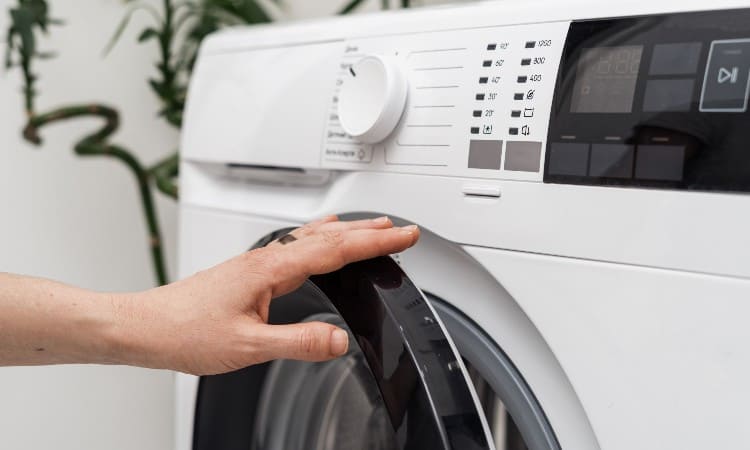Compared to clothing, quilts are bulky items, so they can be tricky to wash, not to mention that some of them are old or delicate as well. But even though quilts are harder to wash than clothing is, they still need to be washed occasionally to remain in good condition.
The best way to wash a quilt depends on how delicate it is and whether or not it is handmade. Most quilts can be washed in the washing machine, but some may need to be washed by hand. In either case, it’s best to use cold water along with a gentle detergent and gentle rinsing to prevent damage.
If you’re still concerned about washing a quilt, don’t be. I’ll provide everything you need to know about washing a quilt in the washing machine as well as hand-washing it. Drying the quilt is another major concern, but I’ll explain how to do that as well.

Can You Wash Quilts?
Due to the delicate nature or age of some quilts, many people assume that they are not safe to wash. There are ways to wash a quilt safely, including putting it in the washing machine. However, you have to decide how comfortable you are with putting them in the washing and whether or not you should wash them by hand instead.
Hand-washing quilts is the safest way, especially if the quilts are old. But, you can put them in the washing machine as long as you use the right settings. As far as store-bought quilts are concerned, it is 100% safe to put them in the washing machine provided that they aren’t made with delicate materials or have any sort of embellishments on them.
Can You Put a Quilt in the Washing Machine?
Any type of quilt can technically be put in the washing machine, even if they are delicate or handmade. The washing machine is the easiest and quickest way to wash a quilt, although it may not be the safest way. When dealing with delicate quilts, it’s up to you to decide whether or not the washing machine is worth the risk of damage.
If you choose to wash a quilt in the washing machine, it is very important that you use the right settings. Even though quilts are bulky items, they don’t necessarily need high water temperatures or a lot of agitation to be washed. These settings will certainly get the quilt clean, but they may also cause damage.
Due to their bulkiness, you also need to make sure that your washing machine can handle bulky items. Some machines are better than others at washing bulky items and some machines can become unbalanced when bulky items are washed in them. If you know you’re going to have to continue to get up to balance the machine, it may be easier just to wash it by hand.
But what about top loader vs. front loader washing machines? Can quilts be washed in both of them safely? They can, but it’s much better to wash them in a top loader washing machine. This is because quilts get the cleanest if you allow them to soak for a little while before washing them.
With top loader washing machines, you can fill the drum with water and then add your quilt to let it soak. With front loaders, unless your machine has a “soak” setting, you’ll have to add your quilt first and let the machine fill up with water. Then you’ll have to listen for the machine to switch over to the next cycle so that you can stop the machine. This will allow the quilt to soak for a little while before washing.
Other than that, there is no difference between washing a quilt in a top loader vs. a front loader. The rest of the laundry settings are the same. But again, if you’re unsure or even a little bit uncomfortable about putting a quilt in the washing machine, it’s best to just hand-wash it instead.
How to Wash a Quilt in the Washing Machine

Before washing a quilt, it is recommended that you check the care tag to see what settings are recommended for washing that particular quilt. This is because handmade quilts often don’t have care tags or older quilts. Even store-bought ones may not still have the care tag attached.
With that being said, I’ve provided the recommended washing machines that you need to use to wash both store-bought and handmade quilts. Washing quilts using these settings should keep your quilt safe. But again, you can use your judgment on whether or not you want to wash your quilt in the washing machine using these settings.
Store-Bought Quilts
When washing store-bought quilts, you don’t have to be as careful as you would with homemade or delicate quilts. It’s not that store-bought quilts are made better than homemade ones. Rather, it’s that they are put together in a way that damage is less likely to occur.
Plus, the threads of quilts can weaken over time, no matter how well made they are. It’s much safer to wash store-bought quilts, especially if they are newer than to wash older quilts made with more delicate materials.
Usually, if the quilt is store-bought, you can use your regular detergent and a regular washing cycle provided that the quilt is in good shape and isn’t made with delicate materials. But you can use your judgment on whether you want to use the regular or gentle cycles.
In either case, washing the quilt in cold water is recommended to prevent the colors from bleeding and the fabric shrinking. Begin by letting the quilt soak in the water for about 30 minutes before allowing the washing machine to finish cycling through.
Remember that with front loaders, this may involve pausing the machine once it fills up and before it gets to the wash cycle. After the quilt has soaked for 30 minutes, you can restart the machine. With top loaders, let the machine fill with water before adding your quilt, then add the quilt and let it soak for 30 minutes. Finally, add your detergent and start your machine.
Handmade and Delicate Quilts
If you choose to wash a handmade or delicate quilt, including one that is super old (even store-bought ones), you will need to be much more careful with how you wash it. This includes quilts made with delicate fabrics or have any sort of embellishments on them.
When washing quilts that fit into this category, you’ll want to use the cold water setting, combined with a gentle detergent and the gentle or delicate cycle. Gentle detergents often contain milder chemicals that get your quilt clean without causing damage. In contrast, the gentle cycle uses less agitation to rinse the quilts to keep them from getting damaged and torn.
As with store-bought quilts, allow homemade or delicate quilts to soak for about 30 minutes before actually washing them. To do this, follow the guidelines in the previous section depending on whether you have a front loader or top loader washing machine. After the quilt has soaked, double-check that the machine is set to the gentle cycle, and allow the wash to continue.
How Do You Wash a Quilt Without a Washing Machine?

If you don’t have a washing machine, your washing machine can’t handle bulky items, or the quilt is delicate or old and you don’t feel comfortable washing it in the machine, you can hand-wash the quilt instead. Hand-washing is always an option anyway. It just takes longer than using the washing machine.
To hand-wash a quilt, you will need a large tub or use your bathtub instead. Then, fill the tub with enough cool or cold water to completely cover the quilt, then add some gentle detergent to the water. Finally, stir in the detergent to evenly dispersed, then add your quilt to the water and let it soak for about 30 minutes.
After the quilt has soaked, drain all the soapy water from the tub and refill it with clean water. Rinse the quilt by gently swirling it around in the water. You may have to drain the water and repeat the process several times to get all the detergent out.
Once you feel as if the quilt is thoroughly rinsed, drain the water out of the tub one more time. Then, gently squeeze the excess water out of the quilt until the quilt is damp but not soaked. Finally, hang the quilt up to dry.
How to Wash a Quilt Without Bleeding
Some quilts are more prone to bleeding color when washed, especially if the fabric contains many bright colors (particularly red and orange). If you’re making your own quilt and are concerned about bleeding, then it is recommended that you pre-wash your quilting fabric first to allow the colors to bleed some before your finished quilt gets ruined during the first wash.
But, if your quilt is already made and you’re concerned about bleeding, then it’s best to ensure that you wash the quilt in cold water, which is less likely to cause bleeding. It’s also recommended to add a color catcher product, such as Shout Color Catcher, to the water. The color catcher will absorb the dye that bleeds so that it doesn’t get absorbed by the fabric.
How Often Should You Wash a Quilt?
Never washing a quilt is not good for the quilt, but washing a quilt too often is not good either. But sometimes, quilts can get dirty, dusty, or stained, so they’ll need to be washed to keep them in good condition.
If the quilt isn’t used regularly, you can get away with only washing them once per year. That should be enough to remove any dirt or dust accumulated on them. Alternately, you can just vacuum off any dirt or dust off of the quilt provided that it isn’t stained or soiled.
If quilts are used regularly or become stained, it may be necessary to wash them more often. But again, you don’t want to wash them too often as doing so can cause damage over time. If the quilt becomes dirty, then wash it when it gets dirty. If the quilt isn’t dirty but is used regularly, then you can get by with washing it every 4 months or so.
Can You Put a Quilt in the Dryer?
Just like quilts can be washed, you can also put them in the dryer. But again, you’ll want to be careful doing this if the quilt is old or delicate. With that being said, it’s best to only dry store-bought quilts in the dryer. You’ll want to be more careful with handmade or delicate quilts as the dryer can damage them.
How to Dry a Quilt

When drying a quilt in the dryer, using the low heat setting is key. You can use the air-dry setting as well. Either of these settings will prevent shrinking and damage, especially if the quilt is made from cotton or stuffed with cotton batting.
For delicate and handmade quilts, air drying them is the best option. Air drying can also freshen up and remove any odors on the quilt. You can air-dry the quilt either outside or inside. When air drying the quilt outside, be sure to hang it in a shady location, as sunlight can cause the colors in the fabric to fade. If the weather is not ideal for air-drying the quilt outside, you can do it inside by hanging it on a drying rack. Just make sure to dry it in a cool area away from windows.
Conclusion
Quilts can be hard to wash if you don’t know what you’re doing or worry about them becoming damaged. Hopefully, this guide to washing quilts helped. Remember that although you can wash quilts in the washing machine, hand-washing is the safest method to prevent damage from occurring. If you enjoyed this article, share it with others and leave a comment. Thanks for reading!